 |
||
|
||
| ||
Part 2. Products from Scythe, Thermaltake, and TitanPart 1. Arctic Cooling, ASUS, Cooler Master, and GlacialTech productsScythe Katana 2, Kama Cross, and Mine Rev.BNow it's turn to examine Mid-End coolers from Scythe—Katana 2, Kama Cross, and Mine Rev.B. All three coolers offer similar features—100x100x25 mm fans with the nominal speed of 1500 rpm and multi-platform retention modules (for LGA775, Socket 754/939AM2, and Socket 478). The main differences concentrate around the original (even unique) design of the Katana 2, Kama Cross, and Mine Rev.B.  Indeed, if you have a look at the actuating medium of the Katana 2, you'll see the typical tilt of the fins (about 20°). Scythe calls this feature OFCS (Oval Fin Contact Structure). Oval contacts between heat pipes and fins should intensify thermal contact, and tilted fins should contribute to ventilation of near-socket components.  Design of the Katana 2 heat sink also looks interesting—a copper heat sink (38x34x4 mm), three copper heat pipes (6 mm in diameter), and 51 aluminum fins (105x52 mm) with the total heat exchange surface area of 5000 cm2. The heat pipes and heat sink are soldered to each other, but the fins are just tightly pressed to the base.  Design of the other Mid-End product (Kama Cross) is even more strange! It has a combined heat sink with two P¥-shaped fin sections. Scythe calls it X Structure Design. Its objective is to provide advanced thermal results and active ventilation of near-socket components. 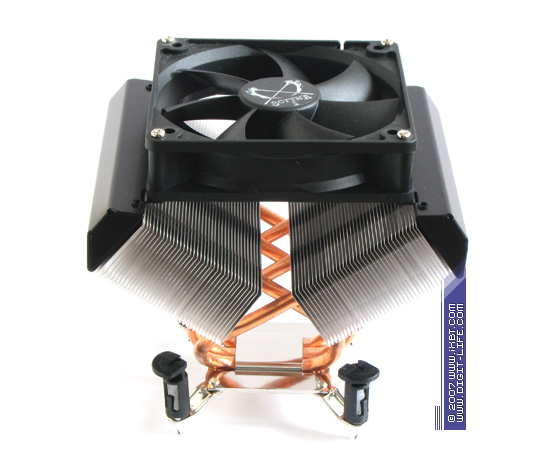 The Kama Cross cooler consists of a copper heat sink (38x34x4 mm), three copper heat pipes (6 mm in diameter), and two sections of aluminum fins (thirty seven 120x30 mm fins in each section with the total heat exchange surface area of about 5000 cm2). Pay attention to special vertical "aprons" on the upper edges of fins, which draw the air into inter-fin channels.  The Mine Rev.B cooler also has an interesting design—a "sandwich" of two fin sections and a central fan. This feature is called AWSF (Advanced Wave Stack Fin)—the sawtooth shape of fins should optimize their hydraulic resistance and muffle some negative acoustic effects. 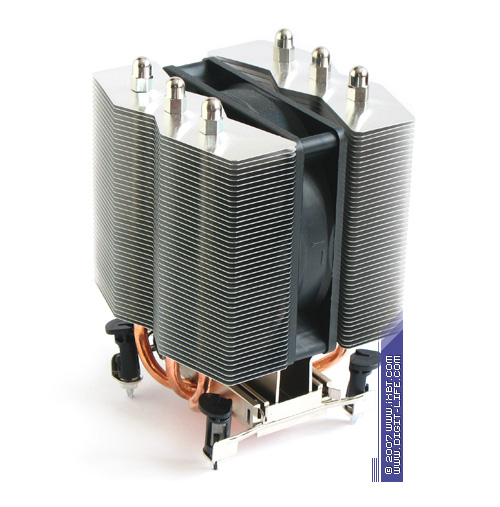 The Mine Rev.B also possesses a nice design—a copper heat sink (36x50x2 mm), three copper heat pipes (6 mm in diameter), and two sections of 46 aluminum fins (110x30 mm). The heat pipes are soldered to the heat sink, but the fins are just pressed tight on the heat pipes.  But practical benefits from these technologies are not always apparent. Judging by test results, only the Mine Rev.B gets some real thermal dividends, while results of the Katana 2 and Kama Cross leave much to be desired. However, this behavior does not come as a surprise: both Katana 2 and Kama Cross have the same drawback—their fins are too dense. This and a slow fan lead to insufficient ventilation and consequently to a slump in thermal efficiently. It seems that Scythe engineers got carried away by purely aesthetic issues. These products can be improved! What concerns the Mine Rev.B, it has a well thought-out design—an optimal fin step (2 mm), reasonable configuration of fin sections, and well-chosen fan ensure maximum utilization of its technical parameters and provide excellent thermal results. So, design "games" of the Katana 2 and Kama Cross are a weakness rather than a forte—their results are generally good, but far from attractive. On the contrary, the Mine Rev.B is praiseworthy! This cooler demonstrates a good bundle of features, excellent results of thermal efficiency and ergonomic characteristics. Coming at an attractive price, it can compete well with Mid- and High-End coolers. Thermaltake TMG i2 and A2Now let's examine TMG coolers from Thermaltake—i2 and A2. Both coolers are based on the same design - copper heat sink (45x32x5 mm), four heat pipes (6 mm in diameter), 58 horizontal fins (90x25 mm). They differ only in retention modules (the i2 is designed for LGA775, while the A2 is intended for AMD). 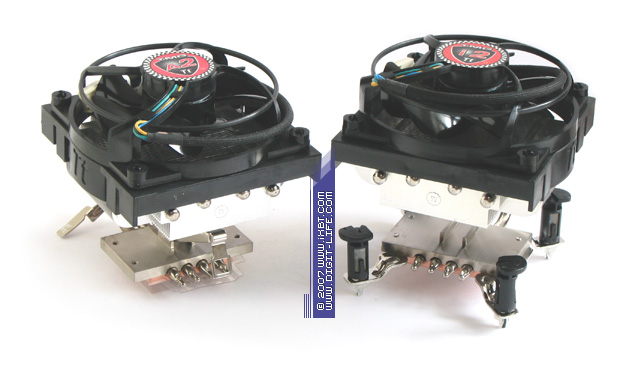 The actuating medium in the i2 and A2 coolers demonstrates an interesting crossing of heat pipes from the heat sink to fins. That is, the hottest two pipes that contact the central part of the CPU cap are peripheral (for better ventilation), two other pipes are cooler, so they go through the center of the heat sink (partially "shaded" by the fan axis). It's quite a reasonable approach! It can bring more dividends in the minimization of thermal resistance department. 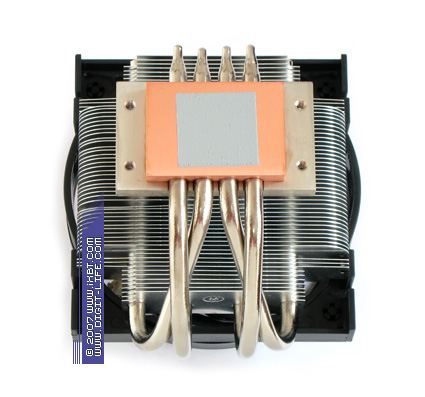 These coolers also have an interesting fan. To be more exact, we are interested in how it's fixed on the mounting frame: it uses special spring-loaded rests, which should dampen structural vibrations and so improve the situation with noise generated by the i2 and A2.  However, these twins apparently keep in the background in practice, demonstrating weak thermal results. Alas! Something is rotten in the State of Denmark! Indeed, additional tests show that the heat sink of the i2 and A2 grows very hot. On one hand, it indicates a good thermal contact between the heat sink, pipes, and fins. On the other hand, it's a sign of insufficient ventilation. This on-board fan (open configuration, low-performance impeller, the actual size is 80x80x25 mm, although the formal form factor is 92x92x32 mm) just does not cope with ventilating dense finning (fin step is 1 mm!) It leads to thermal degradation of a visually promising heat sink. As a result, we have to admit that the TMG i2 and A2 do not come up to their motto (TMG stands for Thermal Maximum Grade). In fact, they can attract customers only with their prices and good usability (reference retention module, low weight, compact dimensions, ergonomic noise). It's up to you to decide whether it all outweighs weak thermal efficiency. Titan TTC-NK45TZ (RB) BomberThe last cooler to be reviewed today is Titan TTC-NK45TZ Bomber. This cooler is based on an interesting design - copper heat sink (40x40x2 mm), two copper heat pipes (6 mm in diameter), 60 aluminum fins (110x45 mm), spiced up with a multi-platform retention module (two brackets with latches for LGA775 are initially installed on the base, a clip for Socket AM2 is included into the bundle).  The TTC-NK45TZ has a much more advanced configuration than the TTC-NK32TZ and TTC-NK34TZ: there are no falling-off low-quality fans anymore. The "open" fan (120x120x25 mm) is secured well on the heat sink. Its design is not brilliant, but quite acceptable. Besides, the fussy heat sink is also a thing of the past (we have no gripes with the contact quality between the heat sink, pipes, and fins). And the multi-platform nature of the new cooler looks much more reasonable than artificial division into two modifications, as in case of the TTC-NK32TZ and TTC-NK34TZ.  This cooler performs very well—it offers much higher thermal efficiency and noticeably better noise ergonomics. Great progress! However, we can still criticize the TTC-NK45TZ a little—its finning is too dense. It is not very efficient with a relatively weak fan (high hydraulic resistance of the heat sink yields low heat release results). The TTC-NK45TZ could have definitely demonstrated better results with a wider fin step! 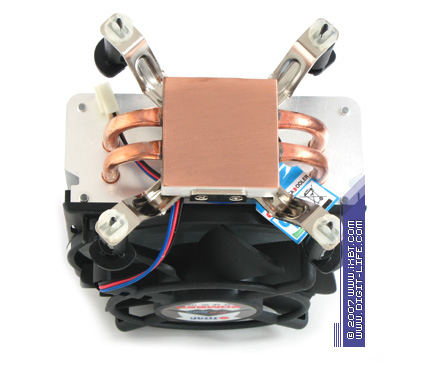 Nevertheless, our conclusion on this cooler is quite positive—the TTC-NK45TZ Bomber is a good choice for its price. It can compete not only with Upper Low-End products (that's its target segment), but also with Mid-End coolers. Titan engineers have learned their lesson with the semi-budget TTC-NK32TZ and TTC-NK34TZ well—the new TTC-NK45TZ is a much more interesting product! So let's hope that Titan will continue to improve the quality and functionality of its Mid-End coolers—there are all prerequisites for it. So, we've examined our main contenders, now it's time to proceed to test results! Note: our shootout also includes several coolers with heat pipes, which haven't been examined here. In particular: 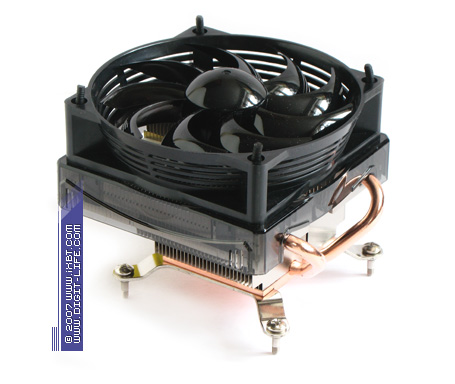 The Cooler Master Vortex 752 offers plain thermal design at a high retail price 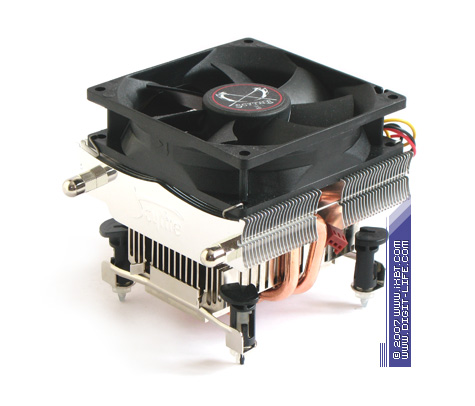 The Scythe Samurai Z Rev.B is based on the old technical solution (its aluminum heat sink is connected to additional fin sections with two heat pipes) and is getting ready for retirement 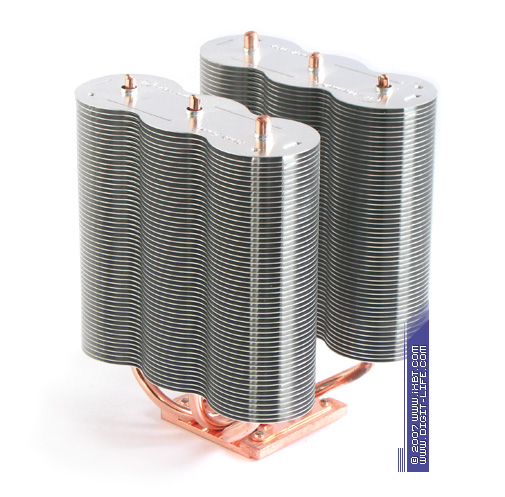 The Thermaltake Sonic Tower Rev.2 is a complete copy of the first revision as far as its design is concerned (we've already reviewed it), it just adds a retention module for Socket AM2. Part 3. Test results (Intel). Summary Table
Part 4. Test results (AMD). Summary Table. Conclusions
Scythe coolers were kindly provided by Scythe
Thermaltake coolers were kindly provided by Thermaltake Vitali Crinitsin (vit@ixbt.com)
January 15, 2008 Write a comment below. No registration needed!
|
Platform · Video · Multimedia · Mobile · Other || About us & Privacy policy · Twitter · Facebook Copyright © Byrds Research & Publishing, Ltd., 1997–2011. All rights reserved. |